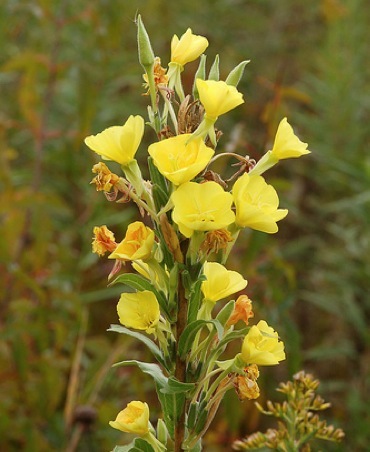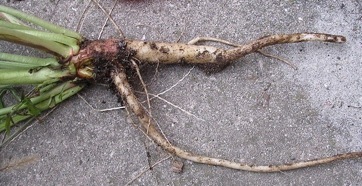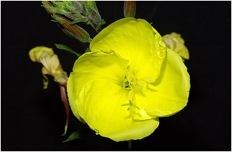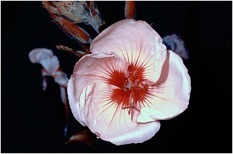Oenothera biennis: Foraging Standby
The Common Evening Primrose has long been a foraging standby and for a century or so was a common vegetable found in European gardens though it’s an American native….probably.
While the edibility of Oenothera biennis (ee-noh-THEER-uh bye-EN-niss) is not in doubt much about the plant is. Linnaeus, who started naming plants in the mid-1700’s, said it was introduced to Europe from North America in 1614. But some modern botanists say it’s native to Europe and went to North America with colonists. Curious: For a plant that might have been native to Europe it certainly was not utilized there until after its discovery in North America. By the 1880s, however, the Evening Primrose was a common garden vegetable in Germany.
The plant’s name also shrouded in a lexicographic fog. Oeno comes from the Greek word Oinos (said EE-nos which later went in to Latin and became vino. “Oi” in combination in Greek is always said “ee”.) Oinos means wine. Thera can mean catcher or hunter. So in polite circles it is interpreted as a root that can absorb wine. There is speculation that ancient (European) hunters would give some wine-soak root to animals to calm them down. I’m not sure that would work and might be a waste of good wine.
Pliny, 23-79 AD, had a different view of the word and wrote: “onothera, sive onear, hilaritatem afferens in vino” which translates into something like “ass catcher, a plant whose juice in wine causes happiness.” A 1601 translation read: “Oenothera, otherwise Onuris, an herb good also in wine to make the heart merry.” The famous botanist Merritt Fernald in 1950 gave up and said it means “wine scented.” Another interpretation is “wine imbibing.” Other views suggest it meant people believed the plant had ability to the calm ferocious man or beast. Biennis means two years, referring to the plant’s growth habit. Primrose means first rose, and since its blossoms open at night “evening” was added to common name a few centuries ago.
During the first year there is only a rosette of basal leaves. Then the second year the plant sends up a tall stalk with alternative leaves and yellow flowers at the top. The flowers open quickly in the evening and, depending on the weather, usually fade by mid morning. The root of the first year plant, cooked, is edible, usually late in the season. Raw it will irritate the throat. Young leaves from the second year stalk were cooked as greens by the Cherokee indians (who first saw Europeans in 1540.) Young second year stalks can also be peeled and eaten. That stalk dried makes a good drill for making fire. Leaves can be eaten if boiled more than once but they are usually tough and gritty. Flower buds can be eaten raw or cooked and the flowers added to salads. The seeds are edible as well (those seeds can also remain viable in the soil for at least 70 years.) Try all parts carefully and sparingly. They can bother the throat of some people even when cooked, and the taste may be acquired.
The young shoots of O. biennis, O. hookeri, and O. lamarckiana are edible raw. Roots of the O. hookeri have been eaten as well. The tough seedpods of the O. californica and O. nuttalli were eaten by the Indians as were the seeds of O. brevipes. O. fruticosa leaves were used as a potherb and it grows throughout eastern North America. Young crown leaves of O. biennis can be blanched and used for salads. People aren’t the only ones who appreciate the Evening Primrose. A lot of insects also like it as well and O. biennis has ultraviolet markings to help the bugs land.
O. biennis is found throughout North America except Idaho, Colorado, Utah, Arizona, and Wyoming.
Green Deane’s “Itemized” Plant Profile
IDENTIFICATION: Lemon-scented, large yellow flowers at the top of a leafy, hairy stalk, stalks, often purple-tinged, erect, 2-6 ft. with leafy, branched stems from a basal rosette. Four-petaled flowers to 2 inches across open at night, close in the day. Second year stalk has lance shaped leaves spiraling up the stem topped by flowers. Seed pod splits into four parts. There is great variability in the plant but it rarely branches.
TIME OF YEAR: Young leaves, flowers and buds, in season, roots near end of first year, second year stalks early in season
ENVIRONMENT: Fields, prairies, thickets, waste ground, disturbed sites, cultivated areas, roadsides, railroads
METHOD OF PREPARATION: Numerous: Roots cooked, usually boiled, peppery. Young shoots – raw or cooked, mucilaginous and peppery. Flowers sweet, used in salads or as a garnish. Young seed pods – cooked, often steamed. The plant also has many medicinal applications.






Is the root or any part of the Oenothera speciosa plant edible? I can’t find any information online, and I would love to try it, but that’s the only primrose species I’ve found around here.
I not found any reference to the edibility of the O.speciosa, which is rather irritating as one finds it farily often.
I found a reference at this website maintained by the University of Texas at Austin, saying this is edible… would be interested in your comments.
http://www.wildflower.org/plants/result.php?id_plant=OESP2
The evening primrose, Oenothera biennis is edible. It is our local version, Oenothera lanciniate that is in question.
I’ve never seen the evening primrose around here, only the O. speciosa. If you find out if they are edible, please let us know!
I saw this on another site… what are your thoughts?
only the first year’s root is used. How can you tell? Evening Primrose is a biannual plant, which means in the first year it forms a rosette of leaves which lie close to the ground. Only in the spring of the second year does the flower stem shoot up. By this time it is too late to dig for the root. However, searching the ground near a stand of second year plants should point the way to some first year plants. The rosette is quite distinctive – its leaves are elongated ovate and pointed, and have a distinctive white midrib. The plant forms a long reddish taproot, which can be a pain to dig up unless the soil is very light. Once dug up they can be used as regular root vegetables in bakes and stews. They have a slightly peppery taste, reminiscent of black salsify.
http://www.sacredearth.com/ethnobotany/foraging/EveningPrimrose.php
Well… there are several species of “Evening Primrose” one of which has several edibles parts and others that have no edible parts. The article makes no distinction. If you have an edible species the roots is best eaten at the end of the first year, read fall after it has had a large basal rosette collecting sun energy all year. When it sends up a flower stalk it is too late because the energy stored the previous year is being used to make the flower stalk.
Is mine the right kind? Because it has branches.
Biennis never branches. But the flower stems might seem like branches to some. Make positive on your ID; perhaps get a local expert to confirm .
Your local county Extension office can identify this with some samples.
This is more of a cousin, but do you know anything about the uses of Primrose Willow? I live in the Tampa bay area and am surrounded by what I’m pretty sure is Ludwigia peruviana.
Thanks for writing. The primrose willow is completely unrelated to the evening primrose, an excellent reason why common names are a constant problem. There are two primrose willows in Florida, Neither have any edible parts.
Please can you provide an accurate photo of the first year plant, the rosette, for the O. biennis? I had this second year plant appear in my yard and now am afraid to pull up any rosette-shaped ‘weed’ for fear of losing one.
Done.
That could be a good thing. We let our yard go a bit sometimes just to see whats growing where and let certain things flower. Many ediblae useful plants have the same habit. Wild lettuce, mullein, chickory and now I am also growing livage and angelica which both do the same thing. You may have other useful things around and not really know it. We leave odd little mounds in our yard here and there just because we like the plants for some reason or other. Good luck.
Mine has a lot of branches????
Great info…cheers
I will be growing to eat 2018 and will let you know..!
Are the leaves flower and roots of Oenothera Macrocarpa edible like other evening primrose?
Thanks; jeff
can i use the flowersto dry once they have closed
It depends on the species.
Is it possible to purchase the edible portion of this plant? If so where? I am growing most of my herbs but with limited growing space I am looking for supplemental herbs for my collection as I move more toward natural healing methods.
Thanks!
I have both common evening primrose and meadow evening primrose in my yard. Is Oenothera pilosella also edible? I’m not finding a reference that theses flowers are also edible.
It’s a pity you don’t have a donate button! I’d without a doubt donate to this superb blog! I guess for now i’ll settle for book-marking and adding your RSS feed to my Google account. I look forward to new updates and will share this blog with my Facebook group. Chat soon!
If you were a real person and not just time-wasting spam you would have noticed I do have a donate button.